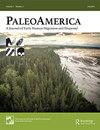北极白令纪与美洲原住民的起源
IF 1.7
Q1 ANTHROPOLOGY
引用次数: 12
摘要
摘要在最后一次冰川盛期(LGM),白令中部低地(又名白令陆桥)一直被视为美洲原住民的屏障或避难所。在这里,我们建议,如果不是更可能的话,创始人群体的LGM家园是白令的北极区。在LGM后的Younger Dryas(YD)寒冷期,人们被吸引到北极白令纪东部,并在LGM前的寒冷期(GS5/HE3)占领了北极白令纪西部。北极白令纪可能为LGM人类种群提供了充足的资源,尤其是在裸露的东西伯利亚北极大陆架(“西北白令纪平原”),在LGM之前和期间,该大陆架为猛犸象和其他大型哺乳动物提供了广阔的草原苔原栖息地。北极白令纪避难所可以解释越来越多的证据,这些证据表明美洲原住民创始人群体与其亚洲来源存在早期(或前)LGM差异。本文章由计算机程序翻译,如有差异,请以英文原文为准。
Arctic Beringia and Native American Origins
ABSTRACT The central lowland of Beringia (aka the Bering land bridge) has been viewed alternately as a barrier or a refugium to the Native American founder population during the Last Glacial Maximum (LGM). Here we suggest that an equally – if not more – likely LGM home for the founder population is the arctic zone of Beringia. People were drawn to eastern arctic Beringia during the post-LGM Younger Dryas (YD) cold period and occupied western arctic Beringia during the cold interval preceding the LGM (GS5/HE3). Arctic Beringia probably contained adequate resources for an LGM human population, especially across the exposed East Siberian Arctic Shelf (“Northwest Beringian Plain”), which supported an extensive steppe-tundra habitat populated by mammoth and other large mammals before and during the LGM. An arctic Beringian refugium would explain a growing body of evidence that indicates an early (or pre-) LGM divergence of the Native American founder population from its Asian source.
求助全文
通过发布文献求助,成功后即可免费获取论文全文。
去求助
来源期刊

PaleoAmerica
Earth and Planetary Sciences-Paleontology
CiteScore
3.70
自引率
0.00%
发文量
15
期刊介绍:
PaleoAmerica disseminates new research results and ideas about early human dispersal and migrations, with a particular focus on the Americas. It fosters an interdisciplinary dialog between archaeologists, geneticists and other scientists investigating the dispersal of modern humans during the late Pleistocene. The journal has three goals: First and foremost, the journal is a vehicle for the presentation of new research results. Second, it includes editorials on special topics written by leaders in the field. Third, the journal solicits essays covering current debates in the field, the state of research in relevant disciplines, and summaries of new research findings in a particular region, for example Beringia, the Eastern Seaboard or the Southern Cone of South America. Although the journal’s focus is the peopling of the Americas, editorials and research essays also highlight the investigation of early human colonization of empty lands in other areas of the world. As techniques are developing so rapidly, work in other regions can be very relevant to the Americas, so the journal will publish research relating to other regions which has relevance to research on the Americas.
 求助内容:
求助内容: 应助结果提醒方式:
应助结果提醒方式:


